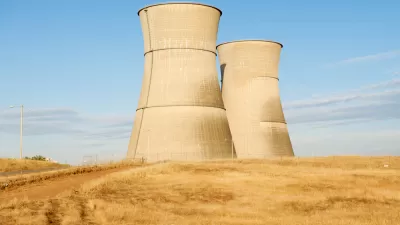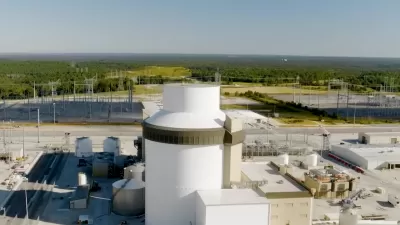A Wyoming coal power plant will be transformed by a company backed by Microsoft co-founder Bill Gates to run on nuclear power. With the signing of the bipartisan infrastructure act, $1.5 billion will help produce zero-emission power by 2028

"TerraPower, a start-up co-founded by Bill Gates to revolutionize designs for nuclear reactors, has chosen Kemmerer, Wyoming, as the preferred location for its first demonstration reactor," writes Catherine Clifford, a climate and technology reporter for CNBC on Nov. 17. "It aims to build the plant in the frontier-era coal town by 2028."
Once built, the plant will provide a baseload of 345 megawatts, with the potential to expand its capacity to 500 megawatts.
It will cost about $4 billion to build the plant, with half of that money coming from TerraPower and the other half from the U.S. Department of Energy’s Advanced Reactor Demonstration Program.]
[Related post on TerraPower: Can Bill Gates Provide America's Next 800 Years of Electricity? September 26, 2013: "For Bill Gates's next act, the Microsoft founder is trying to turn atomic trash into treasure."]
Infrastructure Investment and Jobs Act
“Just yesterday, President Biden signed the Bipartisan Infrastructure Deal and today DOE is already putting it to work with more than $1.5 billion heading to Wyoming,” said Secretary of Energy Jennifer M. Granholm in TerraPower's press release on Nov. 16.
"The U.S. Department of Energy is extremely excited about this project and plans to invest nearly $2 billion to support the licensing, construction and demonstration of this first-of-a-kind reactor by 2028," wrote Alice Caponiti, a deputy assistant secretary in the energy department's Office of Nuclear Energy.
Not a conventional nuclear reactor
"The Kemmerer plant will be the first to use an advanced nuclear design called Natrium, developed by TerraPower with GE-Hitachi," adds Clifford.
Natrium plants use liquid sodium as a cooling agent instead of water. Sodium has a higher boiling point and can absorb more heat than water, which means high pressure does not build up inside the reactor, reducing the risk of an explosion.
Natrium plants can also store heat in tanks of molten salt, conserving the energy for later use like a battery and enabling the plant to bump its capacity up from 345 to 500 megawatts for five hours.
In addition to improvements in safety, reduction in costs over conventional nuclear plants, and storing energy, "Natrium plants produce less waste, a problematic and dangerous byproduct of nuclear fission," notes Clifford.
Nuclear demonstration plants headed to Pacific Northwest
"Along with Natrium, two other advanced reactors are also expected to operate in the Northwest region," adds Caponiti with DOE's Office of Nuclear Energy.
X-energy announced its plans to site its Xe-100 reactor in the state of Washington and NuScale plans to operate its first advanced small modular light water reactor system at Idaho National Laboratory—making this region the new hub of nuclear innovation.
[Related post: The Next Generation of Nuclear Power Could Come Closer to Home, December 10, 2020]
“The Infrastructure Investment and Jobs Act sends a strong message that the U.S. will support the Advanced Reactor Demonstrations to their full and successful completion,” said Darren Gale, X-energy Vice President and ARDP Program Manager, in X-energy's press release on Nov. 15. “This support ensures the success of our reactor and fuel technology at commercial scale”.
Critics get last word
Nuclear power remains controversial within the energy and science communities. Cliffords explored the opposition from the latter in an earlier and more comprehensive piece for CNBC.
On March 18, for instance, the Union of Concerned Scientists (UCS), a non-profit group of 250 scientists and related professionals, issued a 140-page rebuke of “advanced nuclear” reactor designs.
“It doesn’t make sense to us for either government or industry to devote a lot of resources to pursuing high-risk, low-reward technologies – or technologies that could be even worse than what we have now,” Edwin Lyman, Director of Nuclear Power Safety at the Union of Concerned Scientists in Washington, DC, tells CNBC Make It.
Instead, more federal government spending to improve conventional reactors is a better tactic, according to the UCS.
Additional reading on TerraPower's nuclear plant to be built in Kemmerer, Wyoming:
- Inside Climate News: Bill Gates’ Vision for Next-Generation Nuclear Power in Wyoming Coal Country, Nov. 17, 2021
- Rawlins Times (via Wyoming News Exchange): TerraPower chooses Kemmerer for nuclear reactor, Nov. 20, 2021
And on DOE's commitment to advancing nuclear power:
-
Office of Nuclear Energy: It’s Time for the United States to Demonstrate Advanced Reactors, Oct. 14, 2020
Additional related posts:
- Can Steel Go Green? [More on Bill Gates and energy investments], September 4, 2019
- Bill Gates's Coalition of Rich Investors Buying In to Energy Storage, June 15, 2018
- DOE Clears Way for First Nuclear Construction in 30 Years, February 19, 2014
Hat tip to Eric Gilbertson.
FULL STORY: Bill Gates’ TerraPower aims to build its first advanced nuclear reactor in a coal town in Wyoming

Alabama: Trump Terminates Settlements for Black Communities Harmed By Raw Sewage
Trump deemed the landmark civil rights agreement “illegal DEI and environmental justice policy.”

Planetizen Federal Action Tracker
A weekly monitor of how Trump’s orders and actions are impacting planners and planning in America.

The 120 Year Old Tiny Home Villages That Sheltered San Francisco’s Earthquake Refugees
More than a century ago, San Francisco mobilized to house thousands of residents displaced by the 1906 earthquake. Could their strategy offer a model for the present?

Ken Jennings Launches Transit Web Series
The Jeopardy champ wants you to ride public transit.

BLM To Rescind Public Lands Rule
The change will downgrade conservation, once again putting federal land at risk for mining and other extractive uses.

Indy Neighborhood Group Builds Temporary Multi-Use Path
Community members, aided in part by funding from the city, repurposed a vehicle lane to create a protected bike and pedestrian path for the summer season.
Urban Design for Planners 1: Software Tools
This six-course series explores essential urban design concepts using open source software and equips planners with the tools they need to participate fully in the urban design process.
Planning for Universal Design
Learn the tools for implementing Universal Design in planning regulations.
Clanton & Associates, Inc.
Jessamine County Fiscal Court
Institute for Housing and Urban Development Studies (IHS)
City of Grandview
Harvard GSD Executive Education
Toledo-Lucas County Plan Commissions
Salt Lake City
NYU Wagner Graduate School of Public Service





























